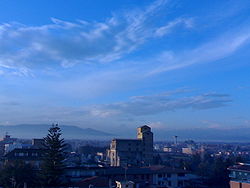Cisterna di Latina
| Cisterna di Latina | ||
|---|---|---|
| Comune | ||
| Comune di Cisterna di Latina | ||
 |
||
|
||
| Location of Cisterna di Latina in Italy | ||
| Coordinates: 41°36′N 12°50′E / 41.600°N 12.833°E | ||
| Country | Italy | |
| Region | Lazio | |
| Province / Metropolitan city | Latina (LT) | |
| Frazioni | Borgo Flora, Olmobello, Prato Cesarino, Le Castella, Doganella, Sant'Ilario-Castelverde, Isolabella | |
| Government | ||
| • Mayor | Eleonora Della Penna | |
| Area | ||
| • Total | 144.16 km2 (55.66 sq mi) | |
| Elevation | 77 m (253 ft) | |
| Population (31 July 2015) | ||
| • Total | 36,795 | |
| • Density | 260/km2 (660/sq mi) | |
| Demonym(s) | Cisternesi | |
| Time zone | CET (UTC+1) | |
| • Summer (DST) | CEST (UTC+2) | |
| Postal code | 04012 | |
| Dialing code | 06 | |
| Patron saint | St. Roch | |
| Saint day | August 16 | |
| Website | Official website | |
Cisterna di Latina is a town and comune in the province of Latina in Lazio, of central Italy. It was the scene of the Battle of Cisterna in January 1944.
The Garden of Ninfa is located in the commune's territory.
The town, then known as Tres Tabernae ("The Three Taverns") is mentioned in the Acts of the Apostles as one of the towns where Saint Paul stopped on his way to Rome.
At Finocchione, in the territory of Cisterna, traces of prehistoric human presence have been discovered. In historic times, the Volsci founded here their still unidentified centre called Ulubrae, although the lost city of Suessa Pometia could also have been located nearby. Ulubrae is mentioned by Horace, Pliny the Elder, Suetonius, Cicero and Juvenal, referring to the numerous patrician villas built here. According to Suetonius, Augustus lived here in his family villa until the age of eighteen.
A village, called Tres Tabernae, originated starting from 312 BC as a post station on the Via Appia, its name stemming from the presence of three . The site is mentioned in the Acts of the Apostles as the place where St. Paul stopped during his journey to Rome, and was housed by the local Christian community. Around the 3rd century AD, the area was invaded by marshes, and the inhabitants of Ulubrae likely moved to Tres Tabernae, which grew in importance and became a Christian bishopric site with a Palaeo-Christian cathedral dedicated to St. Paul. In 307, emperor Flavius Severus was assassinated here by Heraclius, by order of rival usurper Maxentius. The barbarian invasions in Italy caused further expansions of the marshes, and Tres Tabernae declined until, in 592, pope Gregory I united its diocese to that of Velletri. Later in the high Middle Ages, Tres Tabernae was ravaged several times by the Saracens, until it was completely destroyed in 868.
...
Wikipedia


